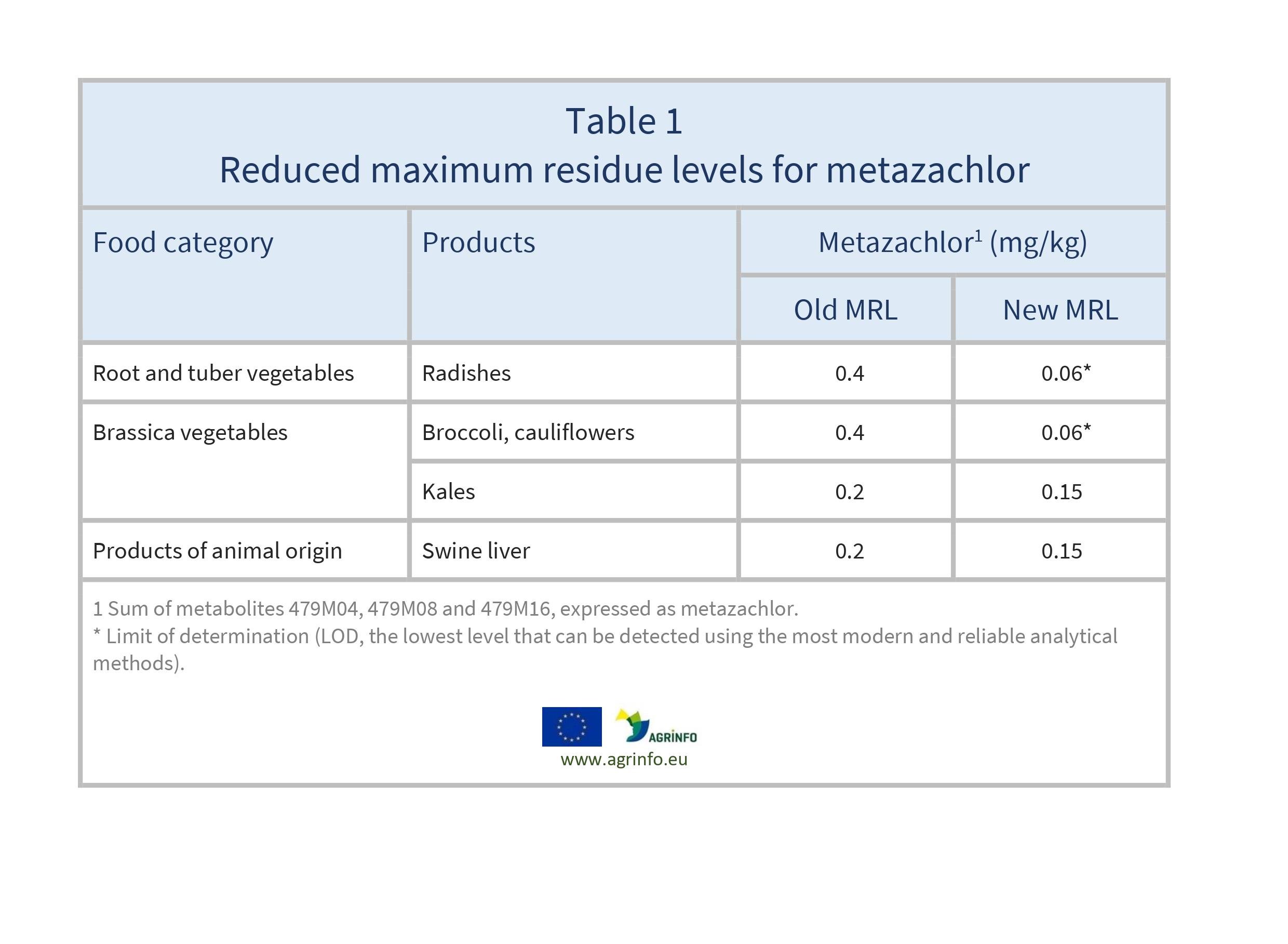Maximum residue levels for metazachlor
- Pesticide MRLs
Summary
The European Commission has raised the maximum residue levels (MRLs) for metazachlor on leeks and honey.
EU raises MRLs for metazachlor on leeks and honey
Commission Regulation (EU) 2024/1078 of 15 April 2024 amending Annexes II and IV to Regulation (EC) No 396/2005 of the European Parliament and of the Council as regards maximum residue levels for azoxystrobin, flonicamid, isofetamid, mefentrifluconazole, metazachlor, pyrimethanil and quartz sand in or on certain products
Commission Regulation (EU) 2023/377 of 15 February 2023 amending Annexes II, III, IV and V to Regulation (EC) No 396/2005 of the European Parliament and of the Council as regards maximum residue levels for benzalkonium chloride (BAC), chlorpropham, didecyldimethylammonium chloride (DDAC), flutriafol, metazachlor, nicotine, profenofos, quizalofop-P, sodium aluminium silicate, thiabendazole and triadimenol in or on certain products
Update
The European Commission has raised the maximum residue levels (MRLs) for metazachlor on leeks and honey.
Impacted Products
Leeks, honey; also radishes, broccoli, cauliflowers, kales, swine liver
What is changing?
The EU has raised the MRLs for metazachlor:
- on leeks from 0.06 to 0.3 mg/kg
- on honey from 0.05 to 0.08 mg/kg.
Why?
Following an application for a modification of the MRL for leeks and honey, EFSA (2023) concluded that the proposed amendments were acceptable for consumer safety.
Timeline
The new MRLs for metazachlor will apply from 6 May 2024.
Recommended Actions
Suppliers of leeks and honey should maintain existing good agricultural practices (GAP) to ensure compliance with the new MRLs by May 2024.
Background
Regulation (EU) 2023/377 of 15 February 2023 reduced the MRLs for metazachlor on radishes, broccoli, cauliflowers, kales, and swine liver to the limit of determination, based on the conclusion by EFSA (2019) that lower MRLs should be applied on these products (Table 1). At that time, the applicant did not provide sufficient data to support the intended use on leeks. This data has since been provided and subjected to EFSA evaluation.
MRLs are set in accordance with the rules set out in Regulation 396/2005. For information on current MRLs for other substances, please consult the EU Pesticide Residues database.
Resources
EFSA (2023) Modification of the existing maximum residue levels for metazachlor in leeks and honey. EFSA Journal, 21(8): 1–27.
EFSA (2019) Evaluation of confirmatory data following the Article 12 MRL review and modification of the existing maximum residue levels for metazachlor in various commodities. EFSA Journal, 17(10): 5819.
Sources
Commission Regulation (EU) 2024/1078 as regards maximum residue levels for azoxystrobin, flonicamid, isofetamid, mefentrifluconazole, metazachlor, pyrimethanil and quartz sand in or on certain products
Commission Regulation (EU) 2023/377 as regards maximum residue levels for benzalkonium chloride (BAC), chlorpropham, didecyldimethylammonium chloride (DDAC), flutriafol, metazachlor, nicotine, profenofos, quizalofop-P, sodium aluminium silicate, thiabendazole and triadimenol in or on certain products
Tables & Figures

Source: Commission Regulation (EU) 2023/377
Disclaimer: Under no circumstances shall COLEAD be liable for any loss, damage, liability or expense incurred or suffered that is claimed to have resulted from the use of information available on this website or any link to external sites. The use of the website is at the user’s sole risk and responsibility. This information platform was created and maintained with the financial support of the European Union. Its contents do not, however, reflect the views of the European Union.
EU raises MRLs for metazachlor on leeks and honey
Commission Regulation (EU) 2024/1078 as regards maximum residue levels for azoxystrobin, flonicamid, isofetamid, mefentrifluconazole, metazachlor, pyrimethanil and quartz sand in or on certain products
Commission Regulation (EU) 2023/377 as regards maximum residue levels for benzalkonium chloride (BAC), chlorpropham, didecyldimethylammonium chloride (DDAC), flutriafol, metazachlor, nicotine, profenofos, quizalofop-P, sodium aluminium silicate, thiabendazole and triadimenol in or on certain products
What is changing and why?
The EU has raised the maximum residule levels (MRLs) for metazachlor:
- on leeks from 0.06 to 0.3 mg/kg
- on honey from 0.05 to 0.08 mg/kg.
This is because, following a request to amend the MRLs, the European Food Safety Authority has concluded that these levels are acceptable for consumer safety.
Actions
Suppliers of leeks and honey should maintain existing good agricultural practices (GAP) to ensure compliance with the new MRLs by May 2024.
Timeline
The new MRLs for metazachlor will apply from 6 May 2024.
Tables & Figures

Source: Commission Regulation (EU) 2023/377
Disclaimer: Under no circumstances shall COLEAD be liable for any loss, damage, liability or expense incurred or suffered that is claimed to have resulted from the use of information available on this website or any link to external sites. The use of the website is at the user’s sole risk and responsibility. This information platform was created and maintained with the financial support of the European Union. Its contents do not, however, reflect the views of the European Union.
